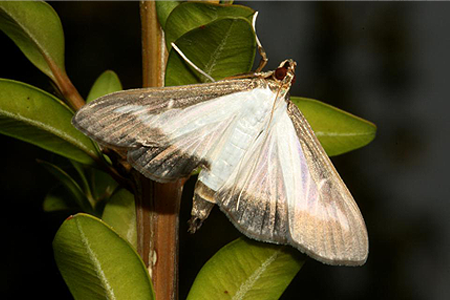Arkansans asked to be on the lookout for invasive, destructive Box Tree Moth
The Box Tree Moth, an invasive insect already a serious pest in Europe may have been accidentally introduced into the United States through landscaping materials.
July 19, 2021
By Mary Hightower
U of A System Division of Agriculture
Fast facts
- Box Tree Moth may have arrived through imported boxwoods
- Moth larvae — caterpillars — can defoliate, girdle plants
- Seen the moth? Call Paul Shell at 501-225-1598
(616 words)
(Newsrooms — with art at https://www.aphis.usda.gov/aphis/newsroom/stakeholder-info/sa_by_date/sa-2021/sa-05/box-tree-moth)
LITTLE ROCK — The Box Tree Moth, an invasive insect already a serious pest in Europe may have been accidentally introduced into the United States through landscaping materials.
Jon Zawislak, extension entomologist for the University of Arkansas System Division of Agriculture, said the moth may have come to the U.S. through a shipment of boxwoods from Canada this spring.

“Canadian boxwoods were shipped to seven states: Connecticut, Massachusetts, Michigan, New York, Ohio, South Carolina, and Tennessee and many of the potentially infested plants were then moved to other states – including Arkansas,” Zawislak said. “The U.S. Department of Agriculture’s Animal and Plant Health Inspection Service is looking to find all infested boxwoods and destroy them as soon as possible before these devastating moths have a chance to become established.”
Zawislak said USDA-APHIS is working closely with the affected states, including Arkansas to find and destroy the imported plants in the receiving facilities. The agency is also trying to trace the sale of imported plants to determine additional locations of potentially infected boxwoods.
USDA-APHIS will provide box tree traps and lures for surveys in the receiving facilities and other locations that received potentially infected plants, he said.
“If you bought a boxwood plant during spring 2021, please inspect it for signs of the moth and report any findings to your local USDA office or state agriculture department,” Zawislak said.
In Arkansas, any findings should be reported to Paul Shell, plant inspection and quarantine program manager for the Arkansas Department of Agriculture. Call 501-225-1598 or email paul.shell@agriculture.arkansas.gov.
On May 26, USDA-APHIS halted importation of boxwoods and two other species, including euonymus and hollies, which are also known to host the moth.
“This is the first known introduction in the United States, and if we can act quickly and thoroughly, we can prevent this pest from becoming established,” Shell said.
How to identify box tree moths
Pupae typically first appear in April or May and will be present through the summer and into the fall, depending on the local climate and timing of generations. Adults first emerge from the overwintering generation between April and July, depending on climate and temperature. Subsequent generations may be active through June to October.
Adults have two color forms, light and dark, and typically live for two weeks after emergence. The wings of the light form moth are white to off-white in the center, with a broad, dusky margin. The dark form is dark gray with two small triangular pots on each wing.
Female box tree moths lay flattened eggs singly or in overlapping clusters of five to more than 20 at a time in a gelatinous mass on the underside of boxwood leaves. Eggs are approximately 1/16 inch in diameter. Female moths can produce more than 42 egg masses in their lifetime. Eggs typically hatch within four to six days.
Once they emerge, the caterpillars will begin feeding on foliage and spinning webs around leaves and twigs to hide and protect themselves from predators. They can grow to be 1.5 inches. The caterpillars are green with. both black stripes and thinner white stripes running the length of their bodies. They also have rows of black spots, from which emerge short, thin spines.
"It may be a low likelihood that we will find any here in Arkansas, but we're better off safe than sorry,” Zawislak said. “When a new insect species is accidentally introduced, we typically have a very short window of time to find and eradicate it before it becomes permanently established and impossible to get rid of. A lot of agencies are working hard right now to see if we can locate and eliminate this pest right away."
For more information and pictures of box tree moths, visit https://www.uaex.uada.edu/environment-nature/ar-invasives/invasive-insects/box-tree-moth.aspx.
To learn about extension programs in Arkansas, contact your local Cooperative Extension Service agent or visit www.uaex.uada.edu. Follow us on Twitter and Instagram at @AR_Extension. To learn more about Division of Agriculture research, visit the Arkansas Agricultural Experiment Station website: https://aaes.uark.edu. Follow on Twitter at @ArkAgResearch. To learn more about the Division of Agriculture, visit https://uada.edu/. Follow us on Twitter at @AgInArk.
About the Division of Agriculture
The University of Arkansas System Division of Agriculture’s mission is to strengthen agriculture, communities, and families by connecting trusted research to the adoption of best practices. Through the Agricultural Experiment Station and the Cooperative Extension Service, the Division of Agriculture conducts research and extension work within the nation’s historic land grant education system.
The Division of Agriculture is one of 20 entities within the University of Arkansas System. It has offices in all 75 counties in Arkansas and faculty on five system campuses.
Pursuant to 7 CFR § 15.3, the University of Arkansas System Division of Agriculture offers all its Extension and Research programs and services (including employment) without regard to race, color, sex, national origin, religion, age, disability, marital or veteran status, genetic information, sexual preference, pregnancy or any other legally protected status, and is an equal opportunity institution.
# # #
Media contact: Mary Hightower
mhightower@uada.edu